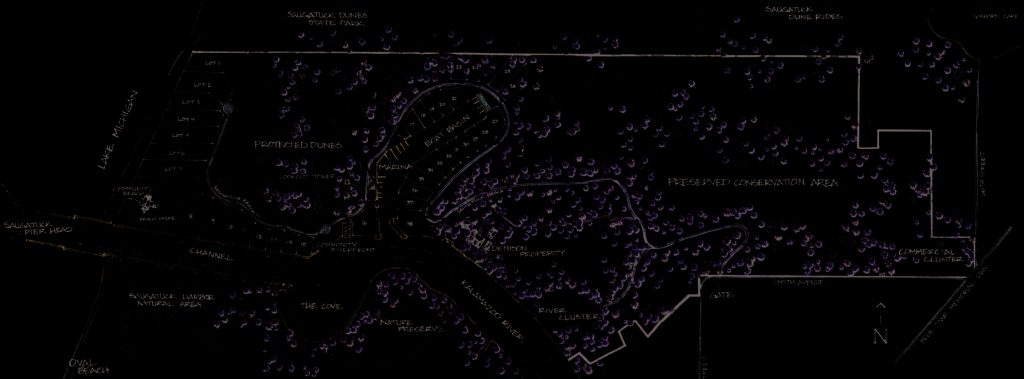
By Scott Sullivan
Editor
The Michigan Supreme Court Friday struck down past local and state appeals court rulings that a dunes preservation group lacked standing to appeal 2017 go-aheads given a proposed NorthShore of Saugatuck development north of the Kalamazoo River channel to Lake Michigan.
The high court by 5-2 decision remanded the issue back to Allegan County Circuit Court to decide based upon refined case law defining what constitutes an “aggrieved party.”
Saugatuck Dunes Coastal Alliance president David Swan and board chair Bobbie Gaunt hailed the ruling as a victory for citizens wishing to have their voices heard based on case merits rather than definitional technicalities.
“The Supreme Court,” countered NorthShore builder Scott Bosgraaf, “did not decide that the SDCA has standing. It determined that for 50 years lower courts have been adding criteria to the standing test or misapplying the law.”
The Alliance sued the township in 2017 claiming its planning commission wrongly granted NorthShore preliminary approvals to build 23 homes around a boat basin where the lost lumber village of Singapore once stood.
The nonprofit land-preservation group — which since 2007 has fought efforts to develop the former Denison/McClendon land fronting Lake Michigan north of the channel — filed in Allegan County Circuit Court June 20, 2017 seeking to overturn the commission’s 6-0 vote April 26 that year to grant preliminary planned unit development (PUD) and site condominium approvals for 95.67 acres of NorthShore owners Jeff and Peg Padnos’ 304 acres there contingent on owners meeting 15 conditions as recommended by township attorney Scott Smith.
Smith, a municipal law specialist for Dickinson Wright of Grand Rapids, told the commission NorthShore’s planned boat basin did not fall within their purview.
Among conditions he recommended for final approval were that the developer obtain needed permits from the U.S. Army Corps of Engineers, Michigan Department of Environmental Quality (now Environment, Great Lakes and Energy/EGLE) and U.S. Environmental Protection Agency for the boat basin.
The DEQ subsequently OK’d its part of it, but five years later the Army Corps, which has purview over hydrology among other things, has not.
The Alliance claimed the commission approved an insufficient preliminary plan despite strong public opposition plus independent legal opinions saying the marina plan conflicts with the township zoning code.
The approval, the suit went on, violates zoning ordinances including: waterfront anti-funneling and density laws against excavating existing channels to increase water frontage, laws pertaining to the removal of 160,000 tons of sand within Michigan’s critical dune boundaries, and multiple inconsistencies with the 2016 Tri-Community Master Plan created by Douglas and Saugatuck cities and the township.
Alliance advocates ran into two township zoning board of appeals, plus two different county circuit court judge and Michigan Appeals Court rulings upholding claims it lacked legal standing based on not demonstrating special damages — environmental, economic or otherwise — different from those that might be sustained by the general public.
Justice Elizabeth Welch wrote the 5-2 majority decision, released Friday, overturning those, saying lower courts must cast a broader net determining what standing standards are.
She was joined by Chief Justice Elizabeth McCormack plus Justices Richard Bernstein, Elizabeth Clement and Megan Cavanagh. Justices Brian Zahra and David Viviano dissented.
The decision, Swan and board Gaunt stated, achieves three things:
• Clarifies citizen participation and good governance;
• Allows the circuit court to hear SDCA arguments regarding township ordinance Section 40-910 that reads “In no event shall a canal or channel be excavated for the purpose of increasing the water frontage.”
Posed that question in 2017, township planners went ahead, on Smith’s counsel, to look at that section’s subsequent qualifying statements, including granting applicants planned unit development (PUD) approval. The SDCA argued then and now “In no event” means never and without exception.
The Alliance elaborated on township ordinance Section 40-337(c)3 which regulates changes to critical dunes which in part says “would not have a materially adverse effect upon the natural contours of the land.”
“NorthShore’s proposal would nearly triple their already-substantial 1,200 feet of frontage by adding 3,200 more feet. This is exactly the kind of proposal the zoning ordinance aims to prohibit; and
• This ruling shows that developers such as Scott Bosgraaf of NorthShore of Saugatuck can no longer view following local zoning as optional,” the SDCA statement said.
